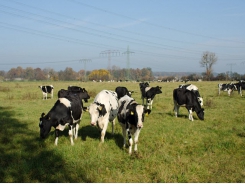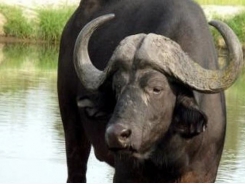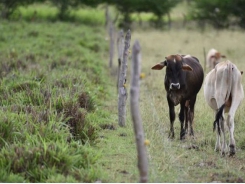Dutch dairy sector comes in below phosphate reduction targets

Phosphate production from livestock manure declined further in the Netherlands in 2018, according to provisional figures released by Statistics Netherlands (CBS).
In 2018, the stats showed that phosphate production in the Netherlands was down by 8.3m kg year-on-year, a decline by 5%.
“This is below the phosphate ceiling as implemented by the EU in the Nitrates Directive for the second consecutive year.”
The national Dutch statistics agency also reported that a total of 160.7m kg of phosphate was emitted in the livestock sector last year, which was over 12m kg below the national phosphate ceiling of 172.9m kg.
There was also a decline in nitrogen excretion, although at 506.1m kg, this amount still slightly exceeds the national nitrogen ceiling of 504.4m kg, according to the CBS report.
Dairy gains
In the dairy sector alone, the phosphate production amounted to 77.4m kg in 2018, a reduction by 9.2m kg relative to 2017 and 9% below the ceiling imposed on this sector (84.9m kg).
Phosphate production from beef cattle rose slightly year-on-year and stood at 11.2m kg, found the CBS.
In 2017, the Dutch phosphate reduction plan came into force in the dairy sector, agribusiness interests, together with the Ministry of Economic Affairs, drew up a package of measures aimed at curbing phosphate production by the entire Dutch livestock herd to a level permissible under the Nitrates Directive (172.9m kg of phosphate) by the end of 2017.
The package consisted of three measures that targeted dairy farmers, namely: reducing the phosphorus content in dairy compound feed, introducing a subsidy program for dairy farms that go out of business and a scheme to reduce the number of dairy cows and young cattle.
Herd reductions, reduced phosphorus content in feed
Considerable reductions in dairy herd size have been made as a result of this plan and the implementation of tradable phosphate rights as of 1 January 2018, noted the report.
Between 1 January 2017 and 31 December 2018, the number of dairy cows in the Netherlands declined by over 190,000 or 11%. The number of calves, weanlings and heifers declined by over 300,000 or 25% over this period.
The phosphate reduction plan has also led to a reduced content of phosphorus in compound dairy cow feed. The phosphorus content declined from 4.3g per kg in 2016 to 4.1g per kg of compound feed in 2018, a decline of over 4%.
In 2018, the phosphorus content of grass and maize - another common type of forage for dairy cattle - was at lower levels than in years previously.
Hike in milk production
The same report shows milk production per dairy cow in the Netherlands grew from over 8,300kg in 2016 to 8,850kg in 2018.
Feed consumption per dairy cow grew as well:
“Over the past few years, the dairy cow’s diet has had a proportionally higher content of grass and feed concentrates due to increased feed consumption and a decline in the cultivation area for forage maize.”
However, the publication noted that grass and concentrates contain up to three times more nitrogen compared to forage maize and thus result in higher nitrogen emission levels per cow.
“Furthermore, the nitrogen content of grass has gone up in recent years. Therefore, despite a reduction in herd size, total nitrogen emissions have barely decreased.”
Less phosphate production on pig farms
Phosphorus production by pigs declined slightly in 2018 due to a small decrease in the number of fattening pigs, according to the data.
It said phosphate production in that sector hit 37.3m kg in 2018.
“Pig farmers were encouraged to switch to feed with lower phosphorus content as part of the phosphate reduction plan for pig farms. This contributed to a decline in phosphate production in the pig farming industry. Partly as a result of these measures, phosphate production has fallen below the 39.7m kg production ceiling in recent years.”
Census blamed for poor results in poultry sector
The report also shows that, in 2018, phosphorus production by the egg-producing poultry sector rose by 4% year-on-year to 21.1m kg. However, in broiler sector, phosphorus production rose by nearly 10% to 6.5m kg.
An amendment, though, to the census method is likely the reason for the trend break in the number of broilers, claimed the authors.
“These changes in phosphorus production were primarily the result of a new poultry registration system. In the 2018 Agricultural Census, the farmer’s own registration was replaced by a census method based on the livestock identification and registration system for poultry.
“In 2018, the number of laying hens rose by 3% to 47.7m while the number of broilers decreased by 10% to 43.2m animals. Total phosphorus production by poultry was just over 1%, however, above the phosphate ceiling of 27.4m kg.”
Có thể bạn quan tâm
Phần mềm

Phối trộn thức ăn chăn nuôi

Pha dung dịch thủy canh

Định mức cho tôm ăn

Phối trộn phân bón NPK

Xác định tỷ lệ tôm sống

Chuyển đổi đơn vị phân bón

Xác định công suất sục khí

Chuyển đổi đơn vị tôm

Tính diện tích nhà kính

Tính thể tích ao hồ




 Improved method for determining allele frequencies may aid…
Improved method for determining allele frequencies may aid…  Healthy pastures may limit nitrous oxide effects from…
Healthy pastures may limit nitrous oxide effects from…